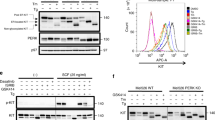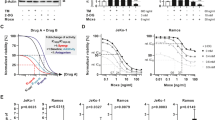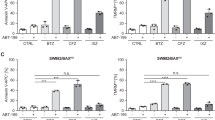Abstract
Oncolytic virotherapy with reovirus has demonstrated anti-cancer activity and minimal toxicity in clinical trials, but the mechanisms underlying these effects have not been fully elucidated. Reolysin, a proprietary formulation of reovirus for cancer therapy, stimulated selective viral replication and apoptosis in multiple myeloma (MM) cells. Reolysin-mediated apoptosis was associated with an induction of endoplasmic reticular (ER) stress-related gene expression, swelling of the endoplasmic reticulum, increases in intracellular calcium levels and a strong induction of the Bcl-2 homology 3 (BH3)-only pro-apoptotic protein NOXA. Knockdown of NOXA expression by short hairpin RNA significantly reduced the pro-apoptotic effects of Reolysin. We next showed that co-administration of Reolysin and bortezomib resulted in the dual accumulation of viral and ubiquitinated proteins, which led to enhanced ER stress, NOXA induction and apoptosis. Importantly, the combination of reovirus infection and proteasomal inhibition significantly decreased tumor burden in a xenograft and syngeneic bone disease model of MM without exhibiting adverse side effects. Our study establishes ER stress stimulation and NOXA induction as novel mediators of reovirus-induced apoptosis. Furthermore, reovirus infection can be used as a promising approach to augment the anti-myeloma activity of bortezomib by promoting additional stress to the endoplasmic reticulum of MM cells.
This is a preview of subscription content, access via your institution
Access options
Subscribe to this journal
Receive 50 print issues and online access
$259.00 per year
only $5.18 per issue
Buy this article
- Purchase on Springer Link
- Instant access to full article PDF
Prices may be subject to local taxes which are calculated during checkout









Similar content being viewed by others
References
Alain T, Kim TS, Lun X, Liacini A, Schiff LA, Senger DL et al. (2007). Proteolytic disassembly is a critical determinant for reovirus oncolysis. Mol Ther 15: 1512–1521.
Carew JS, Medina EC, Esquivel 2nd JA, Mahalingam D, Swords R, Kelly K et al. (2010). Autophagy inhibition enhances vorinostat-induced apoptosis via ubiquitinated protein accumulation. J Cell Mol Med 14: 2448–2459.
Carew JS, Nawrocki ST, Krupnik YV, Dunner Jr K, McConkey DJ, Keating MJ et al. (2006). Targeting endoplasmic reticulum protein transport: a novel strategy to kill malignant B cells and overcome fludarabine resistance in CLL. Blood 107: 222–231.
Clarke P, Meintzer SM, Wang Y, Moffitt LA, Richardson-Burns SM, Johnson GL et al. (2004). JNK regulates the release of proapoptotic mitochondrial factors in reovirus-infected cells. J Virol 78: 13132–13138.
Coffey MC, Strong JE, Forsyth PA, Lee PW . (1998). Reovirus therapy of tumors with activated Ras pathway. Science 282: 1332–1334.
Dallas SL, Garrett IR, Oyajobi BO, Dallas MR, Boyce BF, Bauss F et al. (1999). Ibandronate reduces osteolytic lesions but not tumor burden in a murine model of myeloma bone disease. Blood 93: 1697–1706.
Etoh T, Himeno Y, Matsumoto T, Aramaki M, Kawano K, Nishizono A et al. (2003). Oncolytic viral therapy for human pancreatic cancer cells by reovirus. Clin Cancer Res 9: 1218–1223.
Fernandez Y, Verhaegen M, Miller TP, Rush JL, Steiner P, Opipari Jr AW et al. (2005). Differential regulation of noxa in normal melanocytes and melanoma cells by proteasome inhibition: therapeutic implications. Cancer Res 65: 6294–6304.
Forsyth P, Roldan G, George D, Wallace C, Palmer CA, Morris D et al. (2008). A phase I trial of intratumoral administration of reovirus in patients with histologically confirmed recurrent malignant gliomas. Mol Ther 16: 627–632.
Fribley AM, Evenchik B, Zeng Q, Park BK, Guan JY, Zhang H et al. (2006). Proteasome inhibitor PS-341 induces apoptosis in cisplatin-resistant squamous cell carcinoma cells by induction of Noxa. J Biol Chem 281: 31440–31447.
Gomez-Bougie P, Wuilleme-Toumi S, Menoret E, Trichet V, Robillard N, Philippe M et al. (2007). Noxa up-regulation and Mcl-1 cleavage are associated to apoptosis induction by bortezomib in multiple myeloma. Cancer Res 67: 5418–5424.
Hamamdzic D, Phillips-Dorsett T, Altman-Hamamdzic S, London SD, London L . (2001). Reovirus triggers cell type-specific proinflammatory responses dependent on the autocrine action of IFN-beta. Am J Physiol Lung Cell Mol Physiol 280: L18–L29.
Harrington KJ, Vile RG, Melcher A, Chester J, Pandha HS . (2010). Clinical trials with oncolytic reovirus: moving beyond phase I into combinations with standard therapeutics. Cytokine Growth Factor Rev 21: 91–98.
Hideshima T, Mitsiades C, Akiyama M, Hayashi T, Chauhan D, Richardson P et al. (2003). Molecular mechanisms mediating antimyeloma activity of proteasome inhibitor PS-341. Blood 101: 1530–1534.
Holm GH, Zurney J, Tumilasci V, Leveille S, Danthi P, Hiscott J et al. (2007). Retinoic acid-inducible gene-I and interferon-beta promoter stimulator-1 augment proapoptotic responses following mammalian reovirus infection via interferon regulatory factor-3. J Biol Chem 282: 21953–21961.
Homicsko K, Lukashev A, Iggo RD . (2005). RAD001 (everolimus) improves the efficacy of replicating adenoviruses that target colon cancer. Cancer Res 65: 6882–6890.
Jordan R, Wang L, Graczyk TM, Block TM, Romano PR . (2002). Replication of a cytopathic strain of bovine viral diarrhea virus activates PERK and induces endoplasmic reticulum stress-mediated apoptosis of MDBK cells. J Virol 76: 9588–9599.
Kelly K, Nawrocki S, Mita A, Coffey M, Giles FJ, Mita M . (2009). Reovirus-based therapy for cancer. Expert Opin Biol Ther 9: 817–830.
Kottke T, Hall G, Pulido J, Diaz RM, Thompson J, Chong H et al. (2010). Antiangiogenic cancer therapy combined with oncolytic virotherapy leads to regression of established tumors in mice. J Clin Invest 120: 1551–1560.
Kumar SK, Therneau TM, Gertz MA, Lacy MQ, Dispenzieri A, Rajkumar SV et al. (2004). Clinical course of patients with relapsed multiple myeloma. Mayo Clin Proc 79: 867–874.
Kurozumi K, Hardcastle J, Thakur R, Yang M, Christoforidis G, Fulci G et al. (2007). Effect of tumor microenvironment modulation on the efficacy of oncolytic virus therapy. J Natl Cancer Inst 99: 1768–1781.
Li J, Lee B, Lee AS . (2006). Endoplasmic reticulum stress-induced apoptosis: multiple pathways and activation of p53-up-regulated modulator of apoptosis (PUMA) and NOXA by p53. J Biol Chem 281: 7260–7270.
Libertini S, Iacuzzo I, Perruolo G, Scala S, Ierano C, Franco R et al. (2008). Bevacizumab increases viral distribution in human anaplastic thyroid carcinoma xenografts and enhances the effects of E1A-defective adenovirus dl922-947. Clin Cancer Res 14: 6505–6514.
Marcato P, Shmulevitz M, Pan D, Stoltz D, Lee PW . (2007). Ras transformation mediates reovirus oncolysis by enhancing virus uncoating, particle infectivity, and apoptosis-dependent release. Mol Ther 15: 1522–1530.
Meister S, Schubert U, Neubert K, Herrmann K, Burger R, Gramatzki M et al. (2007). Extensive immunoglobulin production sensitizes myeloma cells for proteasome inhibition. Cancer Res 67: 1783–1792.
Nawrocki ST, Bruns CJ, Harbison MT, Bold RJ, Gotsch BS, Abbruzzese JL et al. (2002). Effects of the proteasome inhibitor PS-341 on apoptosis and angiogenesis in orthotopic human pancreatic tumor xenografts. Mol Cancer Ther 1: 1243–1253.
Nawrocki ST, Carew JS, Dunner Jr K, Boise LH, Chiao PJ, Huang P et al. (2005a). Bortezomib inhibits PKR-like endoplasmic reticulum (ER) kinase and induces apoptosis via ER stress in human pancreatic cancer cells. Cancer Res 65: 11510–11519.
Nawrocki ST, Carew JS, Maclean KH, Courage JF, Huang P, Houghton JA et al. (2008). Myc regulates aggresome formation, the induction of Noxa, and apoptosis in response to the combination of bortezomib and SAHA. Blood 112: 2917–2926.
Nawrocki ST, Carew JS, Pino MS, Highshaw RA, Andtbacka RH, Dunner Jr K et al. (2006). Aggresome disruption: a novel strategy to enhance bortezomib-induced apoptosis in pancreatic cancer cells. Cancer Res 66: 3773–3781.
Nawrocki ST, Carew JS, Pino MS, Highshaw RA, Dunner Jr K, Huang P et al. (2005b). Bortezomib sensitizes pancreatic cancer cells to endoplasmic reticulum stress-mediated apoptosis. Cancer Res 65: 11658–11666.
Nencioni A, Schwarzenberg K, Brauer KM, Schmidt SM, Ballestrero A, Grunebach F et al. (2006). Proteasome inhibitor bortezomib modulates TLR4-induced dendritic cell activation. Blood 108: 551–558.
Neubert K, Meister S, Moser K, Weisel F, Maseda D, Amann K et al. (2008). The proteasome inhibitor bortezomib depletes plasma cells and protects mice with lupus-like disease from nephritis. Nat Med 14: 748–755.
Oyajobi BO, Munoz S, Kakonen R, Williams PJ, Gupta A, Wideman CL et al. (2007). Detection of myeloma in skeleton of mice by whole-body optical fluorescence imaging. Mol Cancer Ther 6: 1701–1708.
Pandha HS, Heinemann L, Simpson GR, Melcher A, Prestwich R, Errington F et al. (2009). Synergistic effects of oncolytic reovirus and cisplatin chemotherapy in murine malignant melanoma. Clin Cancer Res 15: 6158–6166.
Perez-Galan P, Roue G, Villamor N, Montserrat E, Campo E, Colomer D . (2006). The proteasome inhibitor bortezomib induces apoptosis in mantle-cell lymphoma through generation of ROS and Noxa activation independent of p53 status. Blood 107: 257–264.
Puthalakath H, O'Reilly LA, Gunn P, Lee L, Kelly PN, Huntington ND et al. (2007). ER stress triggers apoptosis by activating BH3-only protein Bim. Cell 129: 1337–1349.
Qiao J, Wang H, Kottke T, White C, Twigger K, Diaz RM et al. (2008). Cyclophosphamide facilitates antitumor efficacy against subcutaneous tumors following intravenous delivery of reovirus. Clin Cancer Res 14: 259–269.
Qin JZ, Ziffra J, Stennett L, Bodner B, Bonish BK, Chaturvedi V et al. (2005). Proteasome inhibitors trigger NOXA-mediated apoptosis in melanoma and myeloma cells. Cancer Res 65: 6282–6293.
Reimertz C, Kogel D, Rami A, Chittenden T, Prehn JH . (2003). Gene expression during ER stress-induced apoptosis in neurons: induction of the BH3-only protein Bbc3/PUMA and activation of the mitochondrial apoptosis pathway. J Cell Biol 162: 587–597.
Rhim JH, Tosato G . (2007). Targeting the tumor vasculature to improve the efficacy of oncolytic virus therapy. J Natl Cancer Inst 99: 1739–1741.
Roccaro AM, Hideshima T, Raje N, Kumar S, Ishitsuka K, Yasui H et al. (2006). Bortezomib mediates antiangiogenesis in multiple myeloma via direct and indirect effects on endothelial cells. Cancer Res 66: 184–191.
Rudd P, Lemay G . (2005). Correlation between interferon sensitivity of reovirus isolates and ability to discriminate between normal and Ras-transformed cells. J Gen Virol 86: 1489–1497.
Sei S, Mussio JK, Yang QE, Nagashima K, Parchment RE, Coffey MC et al. (2009). Synergistic antitumor activity of oncolytic reovirus and chemotherapeutic agents in non-small cell lung cancer cells. Mol Cancer 8: 47.
Shmulevitz M, Pan LZ, Garant K, Pan D, Lee PW . (2010). Oncogenic Ras promotes reovirus spread by suppressing IFN-beta production through negative regulation of RIG-I signaling. Cancer Res 70: 4912–4921.
Sidky YA, Borden EC . (1987). Inhibition of angiogenesis by interferons: effects on tumor- and lymphocyte-induced vascular responses. Cancer Res 47: 5155–5161.
Smakman N, van der Bilt JD, van den Wollenberg DJ, Hoeben RC, Borel Rinkes IH, Kranenburg O . (2006). Immunosuppression promotes reovirus therapy of colorectal liver metastases. Cancer Gene Ther 13: 815–818.
Steele L, Errington F, Prestwich R, Ilett E, Harrington K, Pandha H et al. (2011). Pro-inflammatory cytokine/chemokine production by reovirus treated melanoma cells is PKR/NF-kappaB mediated and supports innate and adaptive anti-tumour immune priming. Mol Cancer 10: 20.
Strong JE, Coffey MC, Tang D, Sabinin P, Lee PW . (1998). The molecular basis of viral oncolysis: usurpation of the Ras signaling pathway by reovirus. EMBO J 17: 3351–3362.
Su HL, Liao CL, Lin YL . (2002). Japanese encephalitis virus infection initiates endoplasmic reticulum stress and an unfolded protein response. J Virol 76: 4162–4171.
Sun K, Welniak LA, Panoskaltsis-Mortari A, O'Shaughnessy MJ, Liu H, Barao I et al. (2004). Inhibition of acute graft-versus-host disease with retention of graft-versus-tumor effects by the proteasome inhibitor bortezomib. Proc Natl Acad Sci USA 101: 8120–8125.
Sunwoo JB, Chen Z, Dong G, Yeh N, Crowl Bancroft C, Sausville E et al. (2001). Novel proteasome inhibitor PS-341 inhibits activation of nuclear factor-kappa B, cell survival, tumor growth, and angiogenesis in squamous cell carcinoma. Clin Cancer Res 7: 1419–1428.
Taylor KL, Leaman DW, Grane R, Mechti N, Borden EC, Lindner DJ . (2008). Identification of interferon-beta-stimulated genes that inhibit angiogenesis in vitro. J Interferon Cytokine Res 28: 733–740.
Thirukkumaran C, Morris DG . (2009). Oncolytic viral therapy using reovirus. Methods Mol Biol 542: 607–634.
Thirukkumaran CM, Luider JM, Stewart DA, Cheng T, Lupichuk SM, Nodwell MJ et al. (2003). Reovirus oncolysis as a novel purging strategy for autologous stem cell transplantation. Blood 102: 377–387.
Twigger K, Vidal L, White CL, De Bono JS, Bhide S, Coffey M et al. (2008). Enhanced in vitro and in vivo cytotoxicity of combined reovirus and radiotherapy. Clin Cancer Res 14: 912–923.
van Houdt WJ, Smakman N, van den Wollenberg DJ, Emmink BL, Veenendaal LM, van Diest PJ et al. (2008). Transient infection of freshly isolated human colorectal tumor cells by reovirus T3D intermediate subviral particles. Cancer Gene Ther 15: 284–292.
Vidal L, Pandha HS, Yap TA, White CL, Twigger K, Vile RG et al. (2008). A phase I study of intravenous oncolytic reovirus type 3 Dearing in patients with advanced cancer. Clin Cancer Res 14: 7127–7137.
Wang Q, Mora-Jensen H, Weniger MA, Perez-Galan P, Wolford C, Hai T et al. (2009). ERAD inhibitors integrate ER stress with an epigenetic mechanism to activate BH3-only protein NOXA in cancer cells. Proc Natl Acad Sci USA 106: 2200–2205.
Yoshida H, Matsui T, Yamamoto A, Okada T, Mori K . (2001). XBP1 mRNA is induced by ATF6 and spliced by IRE1 in response to ER stress to produce a highly active transcription factor. Cell 107: 881–891.
Acknowledgements
This work was supported by The Leukemia and Lymphoma Society of America (6319-11), The International Myeloma Foundation, The William and Ella Owens Foundation and the National Cancer Institute P30 Cancer Center Support Grant # CA054174.
Author information
Authors and Affiliations
Corresponding author
Ethics declarations
Competing interests
Dr Coffey is an employee of Oncolytics Biotech Inc.
Additional information
Supplementary Information accompanies the paper on the Oncogene website
Rights and permissions
About this article
Cite this article
Kelly, K., Espitia, C., Mahalingam, D. et al. Reovirus therapy stimulates endoplasmic reticular stress, NOXA induction, and augments bortezomib-mediated apoptosis in multiple myeloma. Oncogene 31, 3023–3038 (2012). https://doi.org/10.1038/onc.2011.478
Received:
Revised:
Accepted:
Published:
Issue Date:
DOI: https://doi.org/10.1038/onc.2011.478
Keywords
This article is cited by
-
BH3-mimetics: recent developments in cancer therapy
Journal of Experimental & Clinical Cancer Research (2021)
-
Bovine pestivirus is a new alternative virus for multiple myeloma oncolytic virotherapy
Journal of Hematology & Oncology (2020)
-
Oncolytic reovirus sensitizes multiple myeloma cells to anti-PD-L1 therapy
Leukemia (2018)
-
The combination of intravenous Reolysin and gemcitabine induces reovirus replication and endoplasmic reticular stress in a patient with KRAS-activated pancreatic cancer
BMC Cancer (2015)
-
BRAF- and MEK-Targeted Small Molecule Inhibitors Exert Enhanced Antimelanoma Effects in Combination With Oncolytic Reovirus Through ER Stress
Molecular Therapy (2015)



